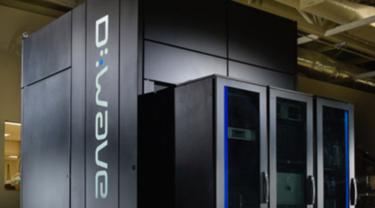In 1969, the Honeywell Kitchen Computer was marketed as a luxury gift item. It would have ushered in the era of home computing, but with a price tag of $10,000 (about $80,000 now), none sold.
The late seventies saw the real advent of home computers and, in just a few decades, we now have powerful technology creating a wear-pattern in our back pockets.
How it all works
Computer chips contain basic modules, which include transistors – basically a switch that can block or allow electricity to flow through.
Today, the typical scale of a transistor is 14 nanometers; 500 times smaller than a red blood cell. As transistors approach the atomic scale, the rules of classical physics no longer apply. We enter the quantum world where, if stopped by a transistor, electrons may just beam themselves through the blocked passage by a process known as quantum tunneling.
To solve this physical barrier to our technological progress, B.C.’s D-Wave Systems has created a quantum computer.
It’s a game changer
Quantum computing has the ability to revolutionize what computer systems can do. “It enables a faster, more effective way to sort through infinite possibilities,” says D-Wave. “From complex optimization problems to machine learning problems and sampling, quantum computing can offer solutions to problems that would take a lifetime to solve, potentially in minutes.”
Global distribution of quantum technology
As it was clear that their customers would include government organizations and Fortune 500 companies, D-Wave had sights set on exporting since the beginning.
By 2010, the bulk of their business would focus outside of Canada, exporting to customers who were beginning to make real progress using this technology. “NASA is developing algorithms for planning and scheduling, machine learning and fault diagnosis,” says D-Wave. “Lockheed Martin is using their D-Wave computer to verify and validate software used in flight control systems and quantum-enabled machine learning, and Google is focused on the exploration of machine learning, with a goal of building more accurate models for everything from speech recognition to bioinformatics.”
A critical export moment
A precarious moment for D-Wave was the first export of their quantum system to the U.S.
“It came in regards to an export permit needed for a refrigerant used in our products,” says D-Wave. Their system hardware has to be kept at 20 milliKelvin, which is near absolute zero, or the coldest temperature in the universe. “We expected the critical path to be navigating the government permit process, but this was surprisingly smooth. Getting the documentation needed for the permit from the end users turned out to be the critical path item.”
Not your typical CPU
One of the main challenges in creating a quantum computer is building a scalable quantum processor. “It requires a tremendous research and development effort,” says D-Wave. “Harnessing quantum effects requires us to create an extreme environment for the processor that is just above absolute zero in temperature (180 times colder than interstellar space) and eliminates noise, magnetic fields, vibrations and more.”
The creation of a quantum computer required new processor architectures, new materials, and designs that are entirely unlike any other computing models.
Of course, starting at just over $15 million, these machines are fairly expensive. As more economical option, D-Wave makes it possible to access a quantum computer via the cloud.
Export insights from Dave Pires, D-Wave Systems’ Vice-President, Engineering
When and why did you first start thinking about exporting as part of your business?
At D-Wave we started thinking about exporting right from the start. With the capital equipment nature of our products, it was clear that our early customers would include Fortune 500 companies and government organizations. By 2010, the customer traction we were seeing confirmed that the bulk of our business would be outside of Canada.
What was your export journey like to get to where you are today?
Our export journey really was one and the same with our commercialization journey. When we began the journey we were a lot smaller (40 people or so) than we are today. It required close collaboration and an amazing team effort across the company. It was a really rewarding experience to be a part of an exceptionally dedicated group that did the research, figured out what we had to do, pulled together the various pieces, and made it all happen.
What is the biggest difference between selling in Canada and selling in another country? How did you adapt to that difference?
While we have Canadian cloud access customers, to date our systems sales have all come from exports. We started an as exporter and are now transitioning to system sales in Canada. For our online cloud access sales there is little difference between selling in Canada or abroad.
Has exporting abroad changed the way you market/sell your products/services in Canada?
There is an enormous worldwide interest in quantum computing and large government-sponsored development efforts underway around the world. This, combined with the traction we have achieved internationally, has raised our profile within Canada. We’re proud to be the leader in this nascent industry that we believe will bring an enormous benefit to Canada. The third party validation we have gained through exports and our relationships with top U.S. and European companies has now opened the door for us within Canada.
What have you learned from exporting that has benefitted your sales/operations in Canada?
So much. Export considerations include understanding the necessary permits and regulatory compliance. It has required learning and continuous improvement for essentially all functions of our operations across the company. The bulk of these operations are in Canada. If you can successfully navigate selling internationally as you build your company, you are well positioned for domestic sales.





